Dryers
An industrial dryer is a device or system designed to remove moisture from a substance or product using heat, cold, air, infrared light, or chemicals. Various techniques can be employed for both batch and continuous drying processes. The specific method depends on the material being handled and the quantity of that material.
Industrial dryers are widely used in sectors such as food processing, mineral and metal production, dye manufacturing, pharmaceuticals, textiles, lumber, paper, glass , explosives, fertilizers, sand, gravel, plastic , rubber, and wastewater treatment. The dried output may vary from powders and solid pieces of various sizes to sheet fabrics.
For food drying, products can include fruits and vegetables in their natural form or processed into crushed, ground, or flaked forms. Examples include cereal, pet food, flour, sugar, and instant potatoes. Meats like beef jerky, dried sausage, and crumbled hamburger, commonly used in camping and survival meals, may also undergo drying, either sliced thinly or ground and crumbled afterward.
The primary process involved in drying is evaporation, where liquid transforms into gas and diffuses into the atmosphere. In some cases, sublimation occurs, where a solid directly changes into a gas.
Industrial Dryers FAQs
What is an industrial dryer used for?
An industrial dryer removes moisture from materials using heat, air, vacuum, or infrared radiation. It’s widely used across industries like food processing, chemicals, pharmaceuticals, mining, and manufacturing to ensure products are dry, stable, and ready for further processing or storage.
How does a freeze dryer work?
A freeze dryer removes water through sublimation. The product is first frozen, then exposed to a vacuum that turns ice directly into vapor, leaving only minimal moisture. This process preserves nutrients, color, and texture, making it ideal for foods and pharmaceuticals requiring long shelf life.
What industries commonly use rotary dryers?
Rotary dryers are often used in mining, fertilizer production, and aggregate processing. Their rotating drums handle heavy or unevenly sized materials efficiently, offering reliable, energy-efficient drying for large-scale Midwest and national manufacturing operations.
What is the difference between batch and continuous dryers?
Batch dryers process one load at a time, ideal for small-scale or varied production runs. Continuous dryers, on the other hand, operate non-stop, drying materials as they move through the system—perfect for high-throughput industrial facilities needing consistent output.
Why are desiccant air dryers important in industrial applications?
Desiccant air dryers use hygroscopic materials like silica gel to absorb moisture from compressed air systems. They prevent corrosion, ensure consistent air quality, and protect sensitive machinery in manufacturing and processing environments across the U.S.
What factors should be considered when purchasing an industrial dryer?
Key factors include the material’s physical characteristics, required moisture level, operation size, and whether the process is batch or continuous. A skilled manufacturer can recommend the most efficient system that meets safety standards and fits the specific industry’s needs.
How do infrared dryers differ from traditional drying methods?
Infrared dryers use radiant energy to dry or cure coatings quickly, unlike conventional systems relying on convection. They’re energy-efficient and ideal for applications like printing and coatings, where fast, uniform drying is critical for production quality.
The History of Dryers
The history of industrial food drying dates back around 14,000 years, initially developed as a method to preserve food for the winter. As agrarian societies took root, preserved food became a valuable commodity. Communities with surplus crops began trading with farmers who grew different produce or with merchants offering various goods, fostering commerce and diversity.
Early food drying methods were primitive yet effective. These included wrapping fruit in dried palm leaves and burying it in hot sand, hanging food strips over a smoky fire, and in colder climates, freezing vegetables overnight, then squeezing out moisture as they thawed. The Greeks, Romans, and Persians utilized the sun and wind to dry fruits and vegetables, while the Chinese and Japanese employed smoke to preserve fish and meat. The Inca of Peru mastered freeze-drying potatoes, and Native Americans freeze-dried seal and walrus meat. Mongolians dried herbs, spices, and tea for trade along the Silk Road. American settlers followed the Native American practice of sun-drying various foodstuffs, including pemmican, a nutritious mixture of meat, fruit, nuts, and seeds, dried on flat rocks or woven mats in the sun.
By removing moisture, larger quantities of food could be stored, transported, and traded, introducing new, exotic products to the West and generating substantial profits in the East. As demand for dried products grew, the need for industrial drying methods emerged, and new techniques were developed. Early dehydration methods were low-tech, primarily involving trays and relying on nature to provide dry conditions, which sometimes led to inconsistent or unsafe results.
At the turn of the 18th century, French inventors Masson and Chollet developed an effective mechanical preservation method. They compressed wet vegetable pulp into cakes, passing them through a heated tunnel at 105°F to remove moisture, creating a long-lasting, lightweight food perfect for sailors and soldiers. While the flavor wasn't great, these rations served their purpose.
Food drying became less common with the invention of the zinc-lidded canning jar, the tin can, and the refrigerator in the late 18th century. However, the process saw a revival when freeze-drying techniques were developed in 1906 by Jacques-Arsène d'Arsonval. Just five years later, the freeze-drying of the rabies virus led to the development of the rabies vaccine.
During the same period, W. K. Kellogg and C. W. Post began producing cereal as part of their health-focused institutes. They created cereals by turning grains into a paste, spreading it on trays, and drying it into flakes in large ovens. Though their health institutes didn’t succeed, the breakfast cereal industry flourished, paving the way for automated food processing. This growth led to a need for larger, faster, and more advanced equipment to keep up with the demand for powdered and granulated food products.
Industrial drying expanded beyond food. During World War II, biologists discovered that freeze-dried blood could remain chemically stable and viable without refrigeration, and it was soon found that penicillin and bone tissue could also be freeze-dried, greatly improving medical support for troops. As technology advanced, so did the need for commercial laundries. In 1800, a hand-cranked clothes dryer was invented, though little is known about it. The first electric clothes dryer was introduced in 1938, and later, a glass viewing door was added to commercial tumble dryers.
As industry and technology progressed, drying methods evolved to handle an ever-growing variety of materials. Natural mats and trays were replaced by sterile stainless steel screens and drums. Air compression techniques became cleaner and more efficient, streamlining food processing, enhancing safety, and increasing efficiency for both manufacturers and consumers. Kilns designed for drying lumber, ceramics, and minerals, such as gypsum and asbestos, helped fuel the construction industry’s expansion.
Industrial Dryers Images, Diagrams and Visual Concepts
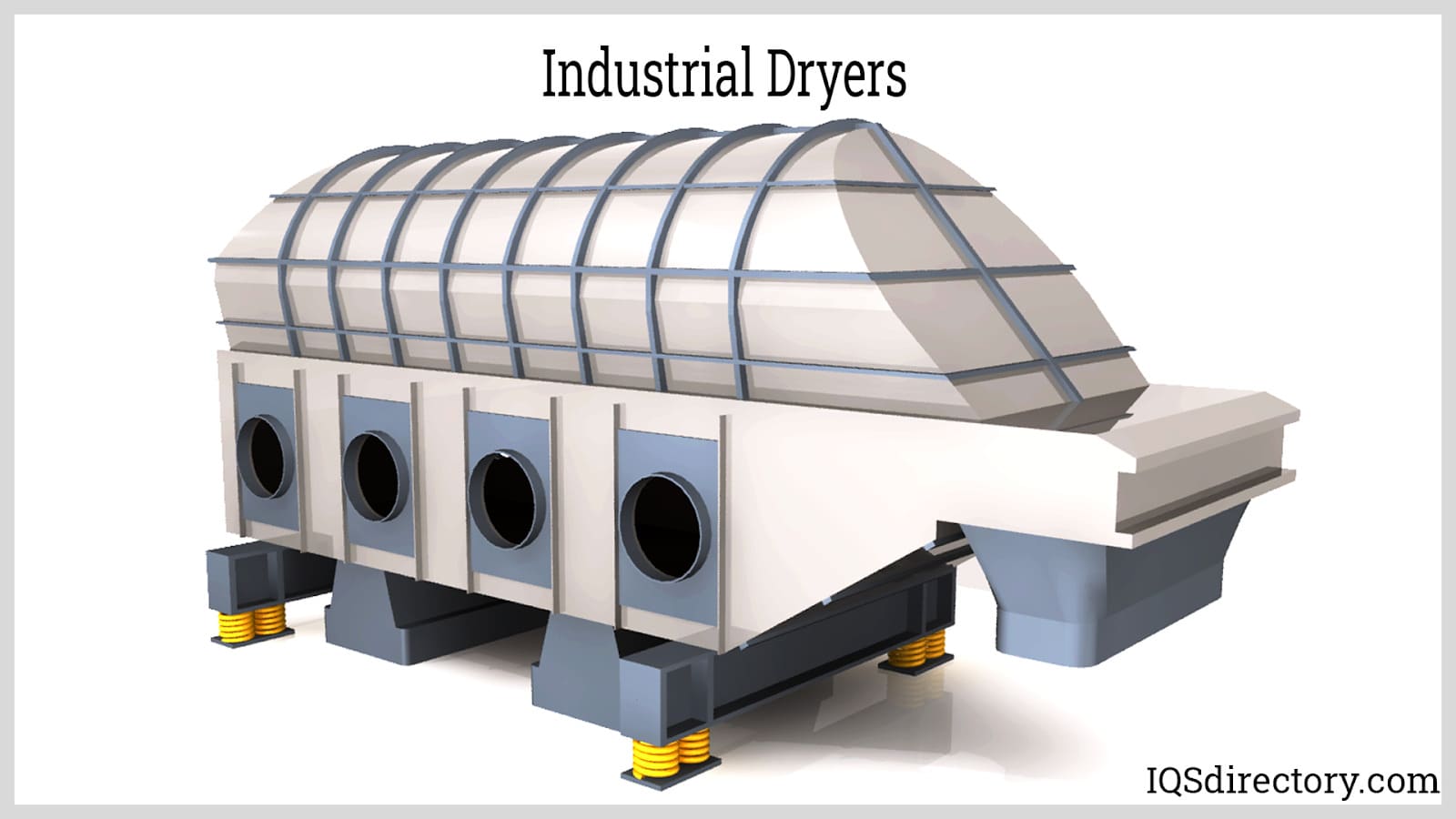 Industrial dryer are high powered device designed to remove moisture from machinery, products, materials, food products, and mixtures.
Industrial dryer are high powered device designed to remove moisture from machinery, products, materials, food products, and mixtures.
 Relative humidity can be manipulated by increasing or decreasing the temperature, the amount of water vapor and the dew point temperature is still the same.
Relative humidity can be manipulated by increasing or decreasing the temperature, the amount of water vapor and the dew point temperature is still the same.
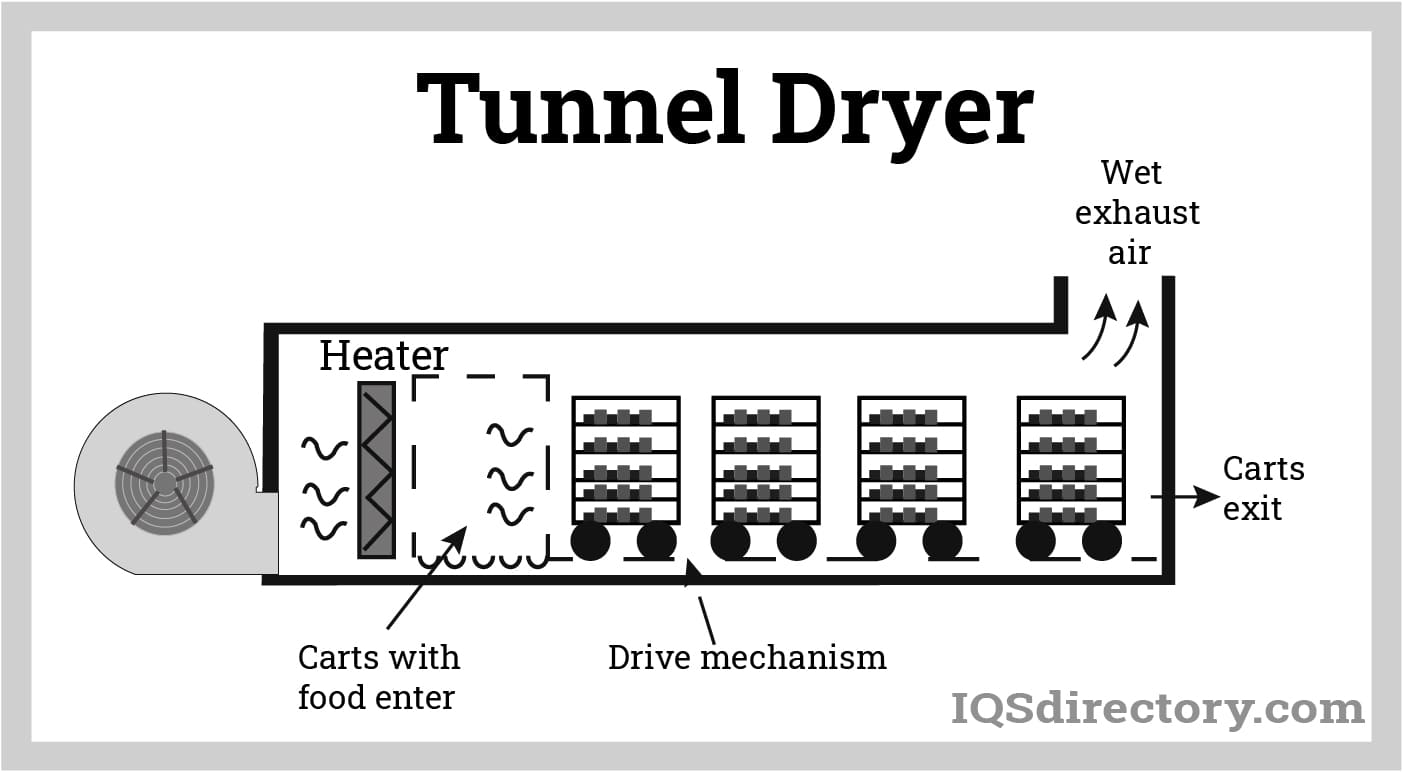 Tunnel dryers, the materials to be dried are loaded in trays attached to a trolley.
Tunnel dryers, the materials to be dried are loaded in trays attached to a trolley.
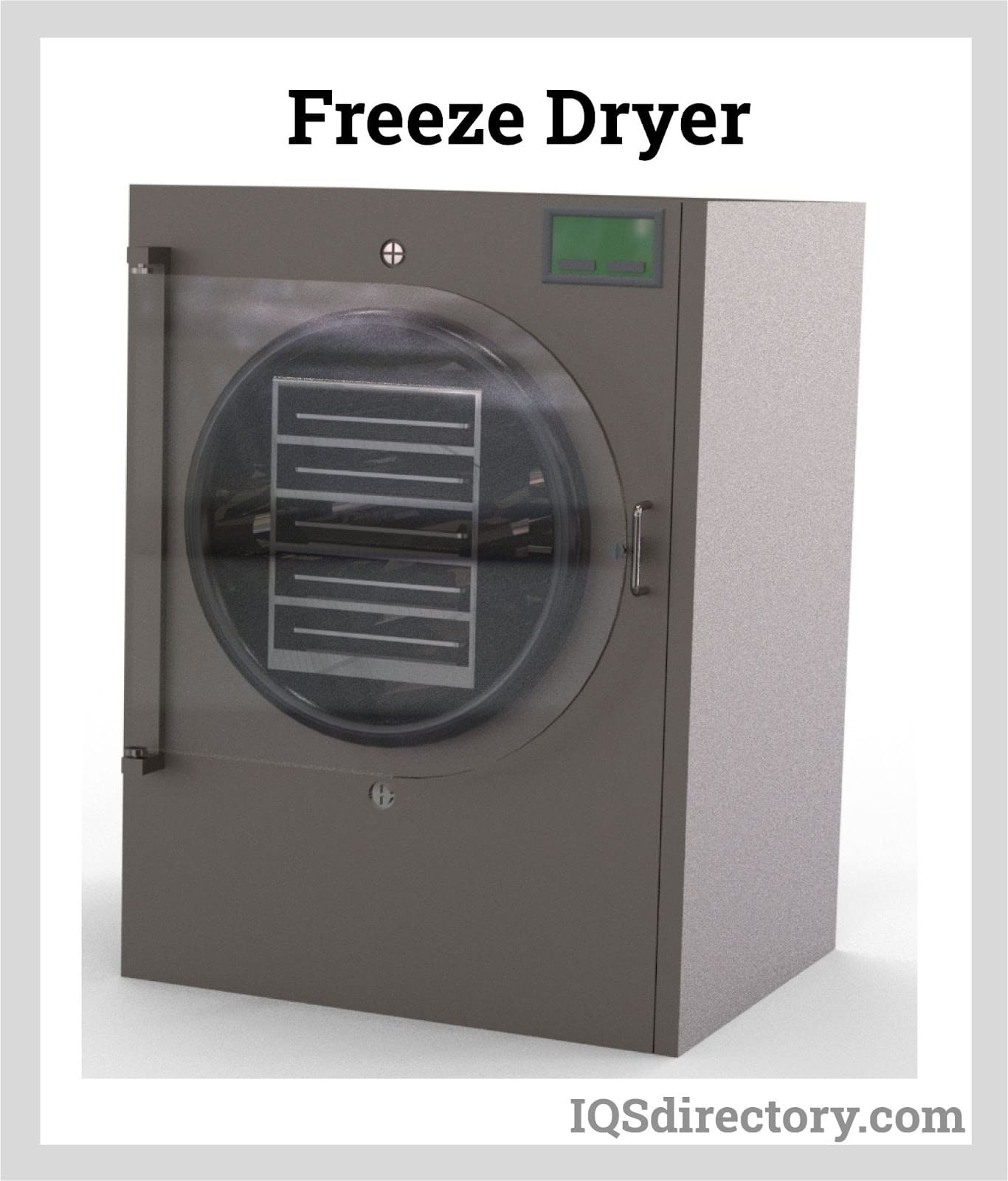 Freeze-drying involves freezing the material to be dried and subjecting it under vacuum pressure.
Freeze-drying involves freezing the material to be dried and subjecting it under vacuum pressure.
 Disc dryers consist of multiple vertical discs mounted on a shaft heated by steam or hot oil, all contained in a horizontal cylinder.
Disc dryers consist of multiple vertical discs mounted on a shaft heated by steam or hot oil, all contained in a horizontal cylinder.
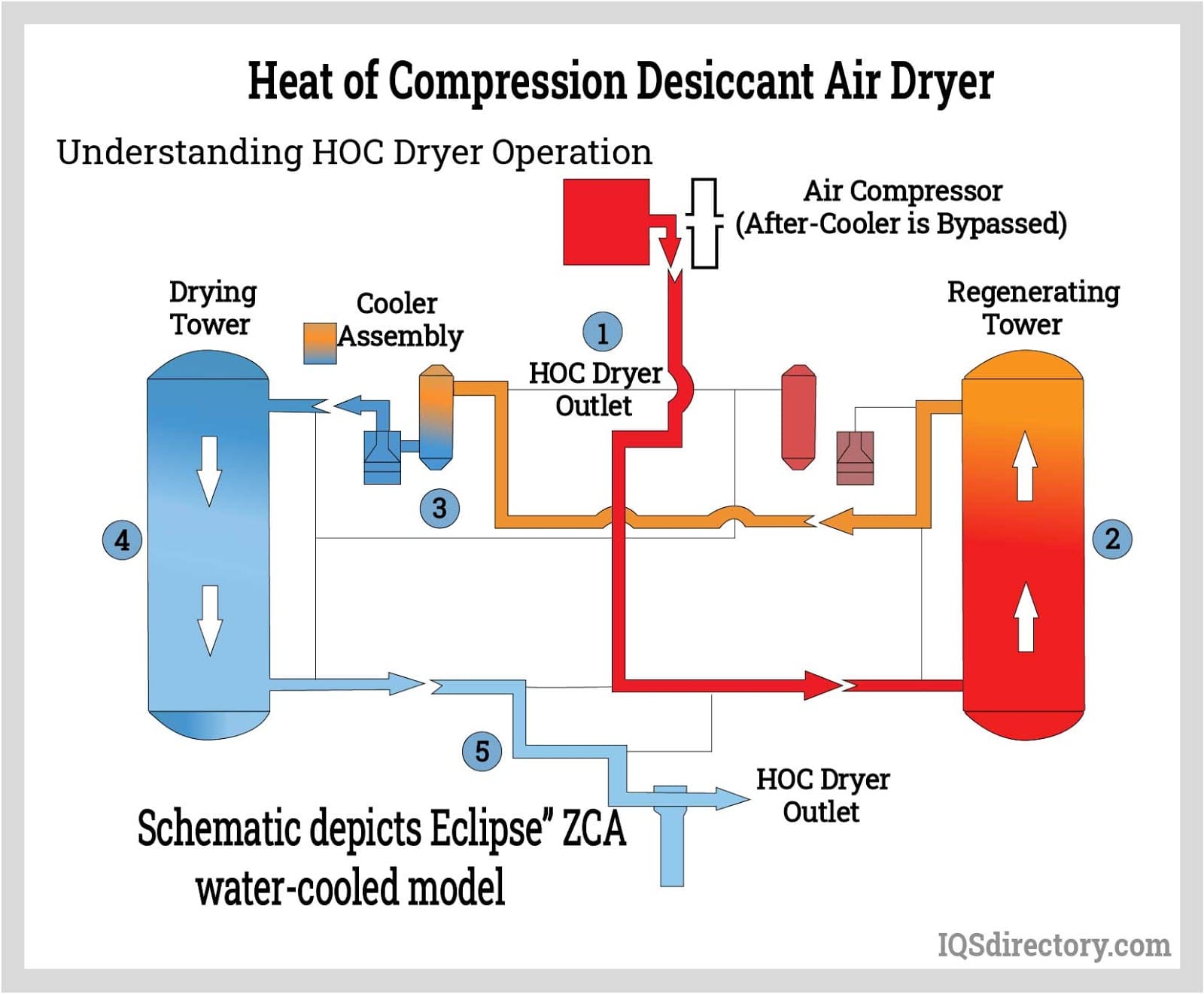 Compression desiccant dryer redirects some of the dried air from the compressor discharge is used.
Compression desiccant dryer redirects some of the dried air from the compressor discharge is used.
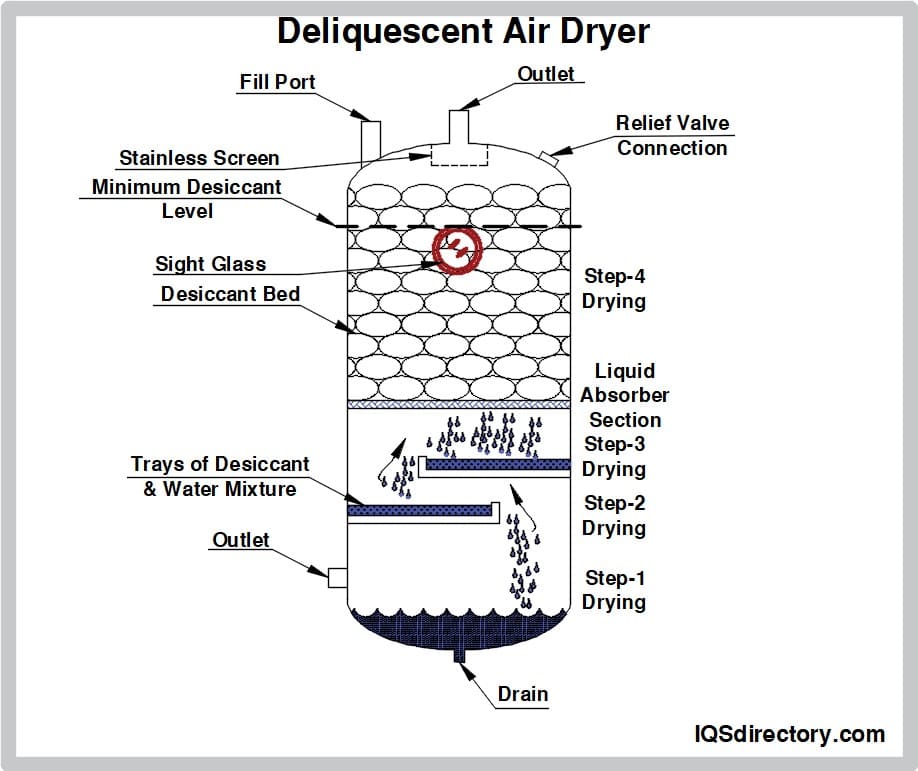 Desiccant dryers use hygroscopic materials to capture moisture from the air.
Desiccant dryers use hygroscopic materials to capture moisture from the air.
Types of Industrial Dryers and Their Uses
-
Fluid Bed Dryer
A fluid bed dryer uses air blown through a permeable membrane to "pick up and drop" particles in a closed chamber, aiding the drying process. The material becomes a dry fluid mass as hot air circulates the chamber. This system is ideal for granulated or powdered solids with uniform particle sizes, such as pharmaceutical powders, food products, and chemicals. Fluid bed dryers are thermally efficient, reducing drying time compared to tray dryers, and are compact, often featuring modular systems with conveyor links. They provide controlled and even drying, making them preferable over tray dryers for most applications.
Rotary Dryer
Also known as a drum dryer, this device utilizes a rotating cylinder, where air passes through the material, tumbling it as it dries. It can be gas-fired or motorized with an electric heating element. Rotary dryers are used to dry materials with inconsistent particle sizes, such as aggregates or fertilizers, and are particularly effective for heavy materials. These dryers are energy-efficient, easy to install, and can be customized for specific needs. Though they tend to be bulky, they are cost-effective and reliable.
Freeze Dryer
A four-step drying process starts with the freezing of the material using mechanical refrigeration, dry ice, or liquid nitrogen. After freezing, the material undergoes primary drying through sublimation, where water is removed without going through the liquid phase. The process continues with secondary drying to adsorb remaining moisture, leaving only 1% to 4% moisture content. Freeze-drying preserves food with minimal nutrient, color, and flavor loss, making it ideal for products with long shelf lives, such as dehydrated food, pharmaceuticals, and microbiological applications.
Air Dryer
Air dryers remove water vapor from compressed air systems, and are classified based on their dew point rating. Desiccant dryers use materials like silica gel to absorb moisture, while refrigerated dryers use a thermal system to prevent condensation. Deliquescent dryers employ a hygroscopic medium in a pressure vessel to absorb moisture, and membrane dryers filter out water molecules. These systems are essential for maintaining the quality of compressed air in various industrial applications.
Flash Dryer
Flash dryers use hot gas or infrared light to remove moisture from material in a very short amount of time. The material is exposed to high heat and gas flow, evaporating the moisture rapidly. Flash drying is energy-efficient, as the material is exposed to heat for minimal time. It's commonly used in drying large quantities of powdered materials, and its efficiency is further boosted by its rapid heat exchange process.
Cyclone Dust Collector
A flash dryer variant, the cyclone dust collector creates a rotating vortex of hot air or gas to dry wet materials. Centrifugal and gravitational forces push dry particles to the outer walls, where they are collected by a bag filter for reuse or disposal. This method is effective in separating solid particles from a gas flow and is commonly used in industries like mining or chemicals.
Double Cyclone
The double cyclone employs a secondary vortex that prevents particles from impacting the outer walls, keeping their structure intact. This configuration allows the system to be used horizontally and improves the efficiency of particle separation. It's often used in wastewater treatment, refinery processes, and sawdust collection systems.
Sludge Dryer
Used to reduce moisture content in wastewater, industrial slurry, or urban sludge, these dryers can remove up to 90% of moisture. The sludge is filtered to a wet cake and then passed through a heated chamber, such as a double cyclone, where the remaining dust is separated. The clean water can be returned to natural systems, making this process environmentally friendly and efficient.
Spray Dryer
In spray drying, slurry is atomized and sprayed into a heated chamber. The water evaporates, leaving the dried material to fall into a collection hopper. This method is efficient for drying heat-sensitive materials and is widely used in industries such as food processing, pharmaceuticals, and chemicals.
Continuous Dryer
A continuous dryer is designed to handle a constant flow of material, drying it as it passes through the system. This setup is ideal for industries that need high throughput without pauses in the process, ensuring consistent quality and efficiency.
Conveyor Dryer
A conveyor dryer uses a belt to move materials through a drying chamber at a steady pace. Common in agriculture and food processing, these dryers offer a continuous drying process that is ideal for large-scale applications like drying fruits, vegetables, or grains.
Compressed Air Dryer
These dryers are designed to remove moisture and contaminants from compressed air systems. Using refrigerant or desiccant processes, they ensure clean, dry air for industrial processes that rely on air compressors.
Food Dryer
Food dryers remove moisture from various edible materials, such as fruits, vegetables, meats, and more. Drying preserves nutrients, flavor, and color while reducing the weight and volume of food products, making them easier to store and transport.
Gas Dryer
Gas dryers use heat to dry materials, commonly used in many industries for a variety of processes. The system heats and dries the product to the desired moisture level, offering an efficient and effective solution for large quantities.
Industrial Dryer
These dryers are essential for removing moisture from materials in industrial or manufacturing settings. They are used to dry everything from raw materials to finished products across various industries, ensuring efficient processing and production.
Infrared Dryer
Infrared dryers use infrared radiation to dry materials quickly. Commonly used in curing water-based inks and coatings in the printing industry, these dryers offer a fast, energy-efficient drying method, particularly for materials that need quick curing or setting.
Parts Dryer
Parts dryers are used to remove moisture from machined components, often using heated air or mechanical processes like spinning or tumbling. These dryers ensure that components are free of moisture before further processing or assembly.
Thermal Oxidizer
Thermal oxidizers are used for pollution control by oxidizing organic materials in the air. They efficiently destroy harmful particles and liquids, reducing environmental contaminants before they enter the atmosphere.
Vacuum Rotary Dryer
Used primarily in the chemical and pharmaceutical industries, vacuum rotary dryers are designed to dry materials at low temperatures under vacuum conditions, ensuring delicate materials are not damaged by excessive heat.
Things to Consider When Purchasing a Dryer
The choice of the right industrial dryer depends on the material being processed and the quantity involved. There are various standard models available, and custom dryers can be designed to meet specific needs. A knowledgeable industrial dryer manufacturer will be able to recommend the most suitable system for your industry, whether it's food processing, mining, or chemicals.
When selecting a dryer, key factors to consider include the physical characteristics of the material being dried, the size of your operation, and whether you're drying single batches or require continuous operation. The manufacturer should also ensure that the equipment meets any relevant legal safety and product standards.
Some processes require additional procedures that can be supported by conveyor systems, while others may involve multiple stages of processing. A skilled manufacturer can guide you through various options to find a solution that maximizes production while minimizing costs and effort. They should also help connect you to suppliers for any pre- or post-drying equipment that can complement or enhance your system.
Your industrial dryer manufacturer should be available to answer questions, offer maintenance advice, and even perform maintenance if needed. They should stand behind their products and provide access to any additional resources that might be necessary for the proper operation and upkeep of your equipment.
Dryer Terms
-
Agglomeration
The process in which particles adhere together to form a small mass, driven by moisture, static charge, or chemical or mechanical binding.
Bag Filter
A filtration system that captures airborne particulates through a mesh or fabric bag.
Boiling Point
The temperature at which the particles in a liquid move rapidly enough to escape the surface and turn into gas or vapor.
Bulk Density
The mass per unit volume of solid materials, commonly expressed in pounds per cubic foot or grams per cubic centimeter.
Conductive Drying
The transfer of heat through a solid material (such as a steel shell) in industrial dryers, separating the heating medium (like steam or oil) from the material being dried. Vapor is typically removed with a condenser and a vacuum pump.
Contact Drying
A drying process where the material directly contacts heated air within industrial dryers.
Diffusion
The process of molecules moving away from areas of higher concentration to areas of lower concentration.
Dry Gas
A gas or gas mixture that contains no water vapor, or one in which all constituents are significantly above their respective saturated vapor pressures at the given temperature.
Evaporation
The process of removing moisture from a substance.
Flash Point
The lowest temperature at which a substance's vapor will ignite upon contact with a flame.
Humidity
The amount of moisture present in the air.
Latent Heat
The energy required to change a substance from one state to another, such as from liquid to gas.
Manometer
An instrument used to measure the pressure of fluids.
Non-Hygroscopic Material
A material that contains only unbound moisture and does not absorb water from the environment.
Oxidation
The process of increasing the oxygen content within a molecule.
Quench
The rapid cooling of combustion exhaust using water sprays.
Radiation
The transfer of heat by infrared radiation through space (air or vacuum) from a warmer mass to a cooler mass.
Sublimation
The direct transition of a substance from a solid to a vapor without passing through the liquid state, typically using heat.
Throughput
The maximum output capacity of industrial heaters, devices, or other machinery, measured over a specified time period.
Vapor
A visible suspension of a substance's particles in the air.
Vitrification
A high-temperature process that melts and transforms non-combustible inorganic materials into a glass-like substance.